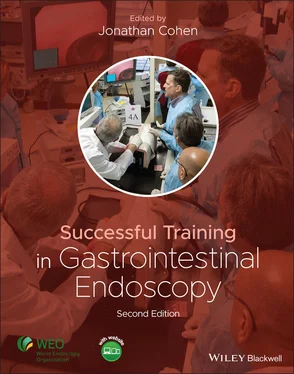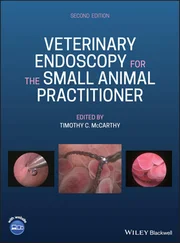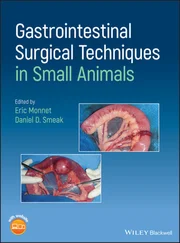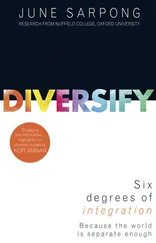Successful Training in Gastrointestinal Endoscopy
Здесь есть возможность читать онлайн «Successful Training in Gastrointestinal Endoscopy» — ознакомительный отрывок электронной книги совершенно бесплатно, а после прочтения отрывка купить полную версию. В некоторых случаях можно слушать аудио, скачать через торрент в формате fb2 и присутствует краткое содержание. Жанр: unrecognised, на английском языке. Описание произведения, (предисловие) а так же отзывы посетителей доступны на портале библиотеки ЛибКат.
- Название:Successful Training in Gastrointestinal Endoscopy
- Автор:
- Жанр:
- Год:неизвестен
- ISBN:нет данных
- Рейтинг книги:3 / 5. Голосов: 1
-
Избранное:Добавить в избранное
- Отзывы:
-
Ваша оценка:
- 60
- 1
- 2
- 3
- 4
- 5
Successful Training in Gastrointestinal Endoscopy: краткое содержание, описание и аннотация
Предлагаем к чтению аннотацию, описание, краткое содержание или предисловие (зависит от того, что написал сам автор книги «Successful Training in Gastrointestinal Endoscopy»). Если вы не нашли необходимую информацию о книге — напишите в комментариях, мы постараемся отыскать её.
Teaches trainee gastroenterologists the endoscopic skills needed to meet the medical training requirements to practice gastroenterology and helps clinical specialists refresh their skills to pass their recertification Successful Training in Gastrointestinal Endoscopy, Second Edition
Successful Training in Gastrointestinal Endoscopy, Second Edition
Successful Training in Gastrointestinal Endoscopy — читать онлайн ознакомительный отрывок
Ниже представлен текст книги, разбитый по страницам. Система сохранения места последней прочитанной страницы, позволяет с удобством читать онлайн бесплатно книгу «Successful Training in Gastrointestinal Endoscopy», без необходимости каждый раз заново искать на чём Вы остановились. Поставьте закладку, и сможете в любой момент перейти на страницу, на которой закончили чтение.
Интервал:
Закладка:
Table of Contents
1 Cover
2 Title Page
3 Copyright Page
4 List of Contributors
5 Foreword
6 Preface
7 Acknowledgments
8 About the Companion Website
9 I: The Evolution of Basic Principles and Practice 1 Training in Endoscopy Introduction Standard training in endoscopy: then and now Standards and end points of current endoscopic training Emergence of complementary teaching modalities The future of simulators in endoscopy training A peek into the future of endoscopic training to 2030 Conclusion References 2 How Endoscopy is Learned Introduction Identification of fundamental endoscopy skills Introduction of the scope Navigation Overcoming obstacles Inspection Instrumentation Simulators and task deconstruction Summary References 3 Training to Become a High‐Quality Endoscopist Preprocedure Intraprocedure Postprocedure Conclusion References 4 Training the Endoscopic Trainer Introduction Training environment Attributes of effective endoscopy trainers Framework for endoscopic training Training aids Train‐the‐trainer programs Conclusions References
10 II: Training in the Major Endoscopic Procedures 5 Esophagogastroduodenoscopy (EGD) Introduction to EGD training Requirements for EGD training EGD training Alternatives for EGD training: simulator‐based training Assessment of performance Conclusions Videos References 6 Colonoscopy Introduction Early skills Intermediate skills How to teach and assess colonoscopy skills Videos References 7 Endoscopic Ultrasound EUS requires different skill sets than standard endoscopy Learning resources for EUS The skill sets needed to learn EUS Pathways for EUS training Complementary training options Conclusion References 8 ERCP Introduction to ERCP training Prerequisite for training ERCP training Alternatives for ERCP training Assessment of performance Training and clinical outcome correlation How much volume is needed to maintain skill—retraining and new techniques The role of the assistant Conclusion Videos References 9 Capsule Endoscopy Introduction Description of the capsules The capsule endoscopy unit Preparing the patient Administering the capsule Capsule endoscopy reading in clinical settings Reading capsule endoscopy study Credentialing the capsule endoscopist: current guidelines Training the capsule endoscopist: current literature Conclusions References 10 Deep Enteroscopy Introduction Prerequisites for training in deep enteroscopy Cognitive component of deep enteroscopy Equipment for deep enteroscopy Technical aspects of enteroscopy training Advancement technique(s) Therapeutic enteroscopy maneuvers Ex vivo training models Conclusion Videos References 11 Cholangioscopy and Pancreatoscopy Introduction Technique of cholangiopancreatoscopy Trainee prerequisites Summary Videos References 12 Principles of Electrosurgery Introduction Basics of electricity as applied to electrosurgery Monopolar and bipolar circuits Safety measures in electrosurgery Tissue effects of electrosurgery in endoscopy Clinical applications of electrosurgery in endoscopy Incorporation of electrosurgical principles into endoscopy training References 13 Training in the Use of Fluoroscopy for Gastrointestinal Endoscopy Introduction Training in fluoroscopy Hardware basics Protective garments Scout films ERCP Fluoroscopy and enteral stents Enteroscopy Lumen‐apposing metal stents (LAMS) Conclusion References 14 Training in Pediatric Endoscopy Introduction Training program requirements Esophagogastroduodenoscopy and colonoscopy Patient assessment Informed consent Sedation Cognitive aspects of training in sedation Technical aspects of training in sedation Upper endoscopy Technical skills Instruments Colonoscopy Cognitive skills Technical skills Instruments Diagnostic techniques in upper endoscopy and colonoscopy Identifying pathology Therapeutic procedures in pediatric endoscopy Percutaneous endoscopic gastrostomy (PEG) Stricture dilation Management of GI bleeding The role of adult endoscopists in pediatrics Defining and assessing procedural competency Assessing competency Simulation in pediatric endoscopy Advanced procedures Endoscopic retrograde cholangiopancreatography (ERCP) Endoscopic ultrasound Wireless video capsule endoscopy References
11 III: Training in Specific Techniques 15 Contrast‐Enhanced Endoscopy Introduction Overview of contrast (image)‐enhancement techniques: chromoendoscopy and other optical techniques Chromoendoscopy FICE, BLI, BLI‐Bright, LCI, and iScan Evidence for effect of training Summary Videos References 16 Training in GI Hemostasis Introduction Prerequisite cognitive knowledge required prior to learning GI endoscopic hemostatic techniques Prerequisite technical knowledge and skills required to learn endoscopic hemostasis Required technical knowledge and skills to be proficient in endoscopic hemostasis Common knowledge and skills for all hemostatic strategies Specific hemostatic strategies Thermal Mechanical Simulators to learn and practice endoscopic hemostasis Available models of endoscopic hemostasis Teaching in endoscopic hemostasis Data supporting the role of hemostasis training on simulators Learning progress in endoscopic hemostasis Concept of integrating simulator work into standard endoscopy training Maintaining skills in endoscopic hemostasis Additional teaching aides for learning GI hemostasis Limitations of GI endoscopy for diagnosis and hemostasis of GI bleeding: teaching pearls for troubleshooting and challenges for the future Definition of minimal thresholds for determining competency in endoscopic hemostasis Requirements to maintain endoscopic hemostasis skills Ongoing challenges in learning new GI hemostasis techniques or improving skills Summary Acknowledgment Videos References 17 Luminal Dilation Techniques (Strictures, Achalasia, Anastomotic, IBD) Introduction Equipment Ancillary devices Endoscope key points to remember Fluoroscopy Mechanism of dilation Technique of dilation Goal Ancillary techniques Contraindications Some key points Achalasia Endoscopy and performance of pneumatic balloon dilation in achalasia Suggested skill set to master and potential outcome measures to assess proficiency in performing luminal dilation Suggested skill level to perform dilation Videos References 18 Management of Foreign Body Ingestion and Esophageal Food Bolus Obstruction Introduction Training in FB extraction Pre‐procedure assessment Identify devices Anticipate the endoscopy Endoscopic removal Further evaluation Conclusions Videos References 19 Endoscopic Mucosal Resection, Submucosal Dissection, and Full Thickness Resection Techniques Introduction Endoscopic mucosal resection Endoscopic submucosal dissection Post‐EMR and post‐ESD management Management of complications When to use EMR and when ESD? Training and first steps in ESD Endoscostrapic Full Thickness Resection using the Ovesco eFTRD® system Conclusions and perspectives Videos References 20 Mucosal Ablation Techniques Introduction Procedures and equipment involved in mucosal ablation Prerequisite cognitive and technical skills for trainees prior to learning mucosal ablation Setting of training Specific knowledge trainees must acquire during training to perform esophageal mucosal ablation Equipment and technical steps Opportunities and methods for training in mucosal ablation Defining competency Maintaining skill level Videos References 21 Complicated Polypectomy Patient assessment and consent Timing Endoscopy Team General principles The electrosurgical unit Carbon dioxide Snares for polypectomy The snare handle as an information center Safety in snare handling Techniques for successful removal of sessile polyps Special techniques for sessile polyps Pedunculated polyps Fluid injection The non‐lifting lesion Retroflexion EMRC Lesions involving the ileocecal valve Lesions at the appendiceal orifice Lesions at the anorectal junction (Video 21.
Читать дальшеИнтервал:
Закладка:
Похожие книги на «Successful Training in Gastrointestinal Endoscopy»
Представляем Вашему вниманию похожие книги на «Successful Training in Gastrointestinal Endoscopy» списком для выбора. Мы отобрали схожую по названию и смыслу литературу в надежде предоставить читателям больше вариантов отыскать новые, интересные, ещё непрочитанные произведения.
Обсуждение, отзывы о книге «Successful Training in Gastrointestinal Endoscopy» и просто собственные мнения читателей. Оставьте ваши комментарии, напишите, что Вы думаете о произведении, его смысле или главных героях. Укажите что конкретно понравилось, а что нет, и почему Вы так считаете.












